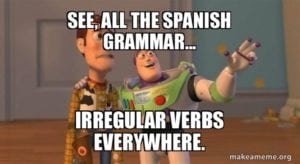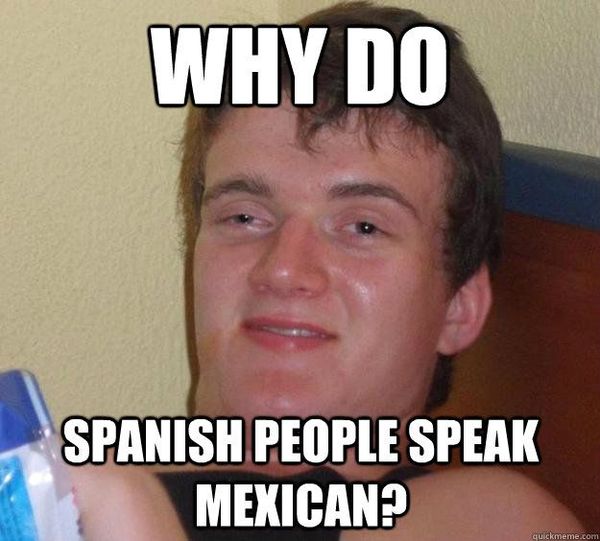Decoding The "English Or Spanish?" Meme: Origins, Humor, And Viral Impact
If you've spent any time scrolling through TikTok, Instagram Reels, or YouTube Shorts recently, chances are you've stumbled upon a video featuring someone asking, "English or Spanish?" followed by an immediate, almost comical, freeze-frame from the person being asked. This seemingly simple question has become a viral sensation, sparking countless memes, skits, and compilations across the internet. But what exactly is the "English or Spanish?" meme, where did it come from, and why has it taken the digital world by storm?
For many, the meme can be a source of confusion, leaving viewers wondering about its origins and the underlying joke. Is it about language proficiency? A cultural debate? Or something else entirely? In this article, we'll dive deep into the fascinating world of this trending meme, exploring its roots, dissecting its humor, and understanding its significant impact on contemporary internet culture.
What Exactly is the "English or Spanish?" Meme?
At its core, the "English or Spanish?" meme is an internet prank challenge that gained immense popularity in 2024. The setup is deceptively simple yet incredibly effective at eliciting a reaction. It typically involves one person approaching an unsuspecting individual or group, predominantly men or boys, and posing the question: "English or Spanish?"
The twist comes immediately after the question is asked. Regardless of the language chosen (or even if no choice is made), the prankster quickly declares, in the chosen language, "Whoever moves first is gay." The participants, including the speaker, would then often remain perfectly still in response, creating a moment of awkward silence and physical rigidity that is central to the meme's humor. This "freezing in place" to avoid being "called gay" is the defining visual element that has made the meme so recognizable across various platforms, from TikTok to Reels.
The Origin Story: @alfonsopinpon_ and TikTok's Viral Spark
Like many viral trends, the "English or Spanish?" meme has a clear origin point, tracing back to the creative mind of TikToker @alfonsopinpon_. Alfonso's prank videos are widely credited with initiating and popularizing this unique challenge, making the "English or Spanish?" question a defining symbol in memes about his content.
In his original videos, Alfonso would approach random individuals in public settings. His approach was direct: he'd ask, "English or Spanish?" to ensure the person understood the language for the next part of the prank. Once the language was established (or even if it wasn't), he would immediately follow up with the declaration, "Whoever moves first is gay" or "If you move, you're gay." The unsuspecting targets, caught completely off guard, would then instinctively freeze, leading to the hilarious and often cringeworthy moments that define the meme. The unexpected nature of being asked "Do you speak English or Spanish?" only to be met with such a bizarre follow-up is key to its virality.
The simplicity and unexpected nature of Alfonso's pranks resonated deeply with TikTok's audience. The videos quickly went viral on For You Pages everywhere, inspiring countless other users to create their own versions. This rapid proliferation transformed a series of prank videos into a full-blown internet phenomenon, with compilations and edits featuring the "English or Spanish" song (often Steve Lacy's "Static") becoming staples.
Unpacking the Humor: Why Did It Go Viral?
The success of the "English or Spanish?" meme lies in a combination of factors that tap into common internet humor tropes:
The Element of Surprise and Awkwardness
A significant part of the humor stems from catching people off guard. The initial question seems innocuous, perhaps leading the target to expect a conversation about language or directions. The sudden, unexpected declaration that follows creates an immediate moment of confusion and awkwardness, which is inherently funny to observers. It's a classic prank challenge setup that plays on social dynamics.
The "Gay" Declaration and "Freezing"
This is arguably the most controversial yet central element of the meme. The humor often comes from the exaggerated reactions of the participants who desperately try not to move, fearing the "gay" label. This plays into a form of social awkwardness and a humorous commentary on perceived fragility, particularly among men or boys who are often the targets. While some might find the premise problematic, many viewers find the intense stillness and the internal struggle of the participants to be comical. Interestingly, some creators even subvert the meme by doing the most flamboyant dance possible after the declaration, proudly embracing the "gay" label and turning the joke on its head, adding another layer to the trend.
Language Contrast and Bilingual Twist
While the core of the prank isn't about testing language proficiency, the initial "English or Spanish?" question sets up a bilingual context. This element adds a layer of unexpectedness and can sometimes lead to humorous misunderstandings or plays on words, especially in bilingual communities. Although the prank's punchline isn't language-dependent, the initial choice frames the interaction, adding to the meme's unique flavor and allowing for creative adaptations that touch on language humor or cultural meme debates.
Beyond TikTok: Cultural Impact and Adaptations
The "English or Spanish?" meme didn't stay confined to TikTok. Its viral nature ensured its spread across various social media platforms, evolving and adapting along the way:
- Skits and Sketches: Meme creators have incorporated the "English or Spanish?" premise into longer skits and comedic sketches, often exaggerating the reactions or setting up elaborate scenarios. They joke about being asked the question in everyday situations.
- Compilations: Numerous YouTube videos and Reels compilations showcase the funniest and most awkward instances of the prank, often set to trending sounds like Steve Lacy's "Static" (Slowed & Reverb).
- Sound Buttons and Meme Generators: The iconic phrase has been turned into instant sound buttons, allowing users to play the sound effect on demand. There are also meme generators specifically for "English or Spanish" memes, enabling quick customization and spread.
- Cultural References: The meme has even seeped into broader cultural humor, with references appearing in contexts like football (e.g., Messi-related "English or Spanish? Meme") or Euro 2024 humor, showing its pervasive reach. It has become a recognizable symbol in online discussions and content.
The meme's journey from a simple prank video to a global phenomenon highlights the power of social media to amplify content and create shared cultural touchstones. It reflects a contemporary internet humor trend that thrives on unexpected twists, relatable awkwardness, and a touch of playful controversy, making it a topic of discussion in online communities and beyond.
In conclusion, the "English or Spanish?" meme, spearheaded by TikToker @alfonsopinpon_, is far more than just a random question. It's a cleverly designed prank challenge where the question serves as a setup for the unexpected declaration "Whoever moves first is gay," leading to hilariously rigid reactions from unsuspecting targets. Its viral spread can be attributed to its element of surprise, the comical awkwardness it generates, and its adaptability across various social media formats. Whether you find it silly, controversial, or simply amusing, there's no denying that the "English or Spanish?" meme has cemented its place as one of the most iconic and talked-about trends of recent times, leaving a lasting mark on the ever-evolving landscape of internet humor.

20 Hilarious Spanish Grammar Memes to Make You Laugh (and Learn)

Amusing spanish people memes joke | QuotesBae

Meme English GIF - Meme English Spanish - Ανακαλύψτε και κοινοποιήστε GIF